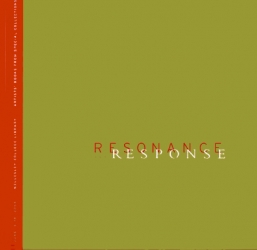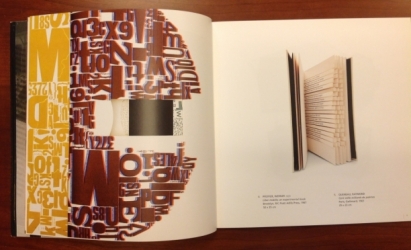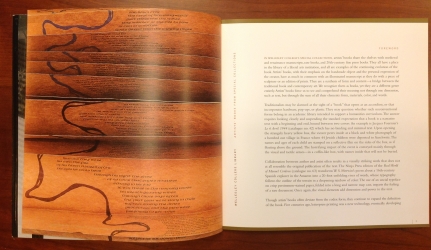In Wellesley College's Special Collections, artists’ books share the shelves with medieval and renaissance manuscripts, rare books, and 20th century fine press books.
They all have a place in the library of a liberal arts institution, and all are examples of the continuing evolution of the book. Artists’ books, with their emphasis on the handmade object and the personal expression of the creator, have as much in common with an illuminated manuscript as they do with a piece of sculpture or an edition of prints. They are a synthesis of form and content—a bridge between the traditional book and contemporary art. We recognize them as books, yet they are a different genre entirely. Artists’ books force us to see and comprehend their meaning not through one dimension, such as text, but through the sum of all their elements: form, materials, color, and words. Traditionalists may be alarmed at the sight of a “book” that opens as an accordion, or that incorporates hardware, pop-ups, or plastic. They may question whether such unconventional forms belong in an academic library intended to support a humanities curriculum. The answer requires looking closely and suspending the standard expectation that a book is a narrative text with a beginning and end, bound between two covers. An example is Jacques Fournier’s Le 6 Avril 1944 (catalogue no. 42) which has no binding and minimal text. Upon opening the strangely heavy yellow box, the viewer peers inside at a black and white photograph of a desolate village in France where 44 Jewish children were deported to Auschwitz. The names and ages of each child are stamped on a reflective film on the sides of the box, as if floating above the ground. The horrifying impact of the event is conveyed mainly through the visual and tactile senses--in a coffin-like box, with names inside that will not be buried.
Collaboration between author and artist often results in a visually striking work that does not at all resemble the original publication of the text. The Ninja Press edition of The Real World of Manuel Cordova (catalogue no. 63) transforms W.S. Merwin’s poem about a 19th century Spanish explorer in the Amazon into a 20-foot unfolding river of words, whose typography follows the outline of the terrain in a deepening rainbow of color. The use of an uncial typeface on crisp persimmon-stained paper, folded into a long and narrow map case, imparts the feeling of a rare document. Once again, the visual elements add dimension and power to the text.
Though artists’ books often deviate from the codex form, they continue to expand the definition of the book. Five centuries ago, letterpress printing was a new technology, eventually developing from industrial art to visual art. The artist’s book incorporates the early hand skills and craft, but pushes the form further into artistic expression. A student in Special Collections can trace the evolution of printing and the graphic arts from incunabula to 19th century dime novels, from the illuminated printing of William Blake to the elaborate productions of the Kelmscott Press, from the woodcut novels of Frans Masereel to the visual narratives of Maureen Cummins.
The library's acquisition of artist's books has always been allied with teaching. In 1945, Research Librarian Hannah French instituted a series of letterpress printing workshops for students and staff. She believed passionately in the value of practical experience so that students could fully appreciate the historical resources of Special Collections. Miss French’s small printing seminars were the foundation for today’s course offerings in the history of the book, papermaking, bookbinding, and limited edition artist books. Aided by alumnae support, and undiminished by the speed and convenience of the digital age, the opportunity for ‘hands-on’ learning has flourished in the Library for the past sixty years.
On this webpage we have published an abridged version of the Resonance and Response exhibition catalogue published in conjunction with ABC: the Artists’ Books Conference, held at Wellesley College on June 15-18, 2005. Marilyn Hatch, former Special Collections Assistant, wrote the label text and mounted the exhibition. The title Resonance and Response invites us to ask what was the inspiration for the book, and how did the artist/author respond to it? Whether a family memory, personal history, beloved place, music, or poetry—the works vary widely in form, but the inspiration behind their creation is often universal.
The Friends of the Library graciously underwrote the entire cost of the published catalogue. Their wise leadership, vision, and support over the years have been essential to the growth of the Library, whose strength is not measured in books alone, but in the loyalty and generosity of the alumnae who studied here.
Ruth R. Rogers
Curator of Special Collections
Wellesley College Library
Follow these links to the catalogue themes:
Concealment and Revelation Revisioning Science Family and Self Place Heritage Social Conscience Music and Word Others' Lives Retelling a Story Nature



